“Once established, the labels used for historical periods are almost impossible to change, even though they may no longer be suitable. The humanists who coined the term Middle Ages thought of the entire thousand years from the fifth to the fifteenth century as an age of darkness: an empty interval between classical antiquity and its rebirth, the Renaissance in Europe.”1 We know better now that this is far from the truth. The Germanic tribes which consistently post threats and eventually sacked the Western Roman Empire in 476 A.D.2 were “barbarous but not primitive.”3 Take a look at the following intricate metal-carving and inlaid work and it is not difficult to see that there was a different form of technologically capable culture brimming on the outskirts of Greco-Roman culture of antiquity.
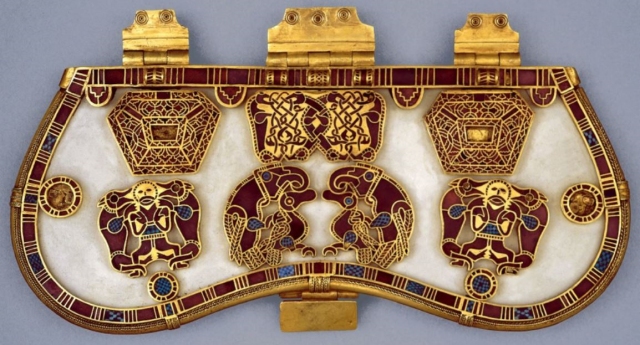 Purse Cover, from the Sutton Hoo ship burial in Suffolk, England, ca. 625. Gold, glass and cloisonné garnets, 7 ½” long.
Purse Cover, from the Sutton Hoo ship burial in Suffolk, England, ca. 625. Gold, glass and cloisonné garnets, 7 ½” long.
As these tribes moved about a lot seasonally, they did not have monumental art-pieces compared to the Greco-Roman world. Instead, they poured their artistic expression into portable items such as brooches, belt buckles, armoury, boats and/or horse harnesses. Of the few artefacts which survived, we see characteristic styles of solid line works of abstract forms reminiscent of animals and plants distinctly containing solid colors. This general animistic4 style was to crossover in influencing illuminated manuscript crafting when these tribes were Christianized.
While the barbarous “others” eroded the Western Roman Empire, the tribes were gradually Christianized by monastic missionaries from the disintegrating Roman Empire. “Monasticism emerged in the fourth century as a reaction against the institutionalization and alignment of Christianity with the Constantinian Empire.”5 After the Edict of Milan in 312 which legalized Christianity, and the later open support of Christian faith by Emperor Constantine, Christianity drew crowds of followers who took up the faith for true spiritual motivation as well as those who whose objectives were mercenary. The weeds among the wheat sought advancement “in their social position or political reputation by ascribing to Christianity. What resulted was a huge influx of poorly catechized members, who lacked genuine fervor and devotion that previously had marked a church of martyrs and mystics, who had to fight and withstand great personal risk and condemnation.”6 In response, many zealous Christians fled to desert places to pursue more austere life in honour of Christ. “These desert dwellers recognized the need to embrace a life of ascetical discipline, centered Scripture, simplicity, and silence. The desert provided an environment for naked dependence on God, a radical return to what was essential: God and God’s providence.”7 At the same time, the desert is a dangerous place. Gradually these Christian hermits converged “together in small clusters, living within view of each other.”8 Others “chose to live together under a common roof with a Rule to guide to their communal life,”9 forming the early prototype of monasticism.
During the consistent struggle to hold on to the Western territories by the Western Roman Empire, monastic communities were established all over Western Europe region that became centers of missionary work in converting the barbarous tribe to the Christian faith. Within the walls of these monastic communities, “copying manuscripts before printing presses were invented”10 was worked into daily routines. One such manuscript produced within the monastic missionaries was the Book of Kells which is “accorded the accolade of being the supreme example of scriptural illumination”11 of its time, c AD 790.
Book of Kells , Illuminated manuscripts, ink on vellum (parchment), approximately 13” X 10”.
The Book of Kells was initiated by the Columcille monastic community on Iona in the latter part of the eighth century, possibly as a memorial to St. Columcille on the 200th anniversary of his death in AD 797. It was a huge project that demanded 180 calf skins from a herd of over 1,000 cattle and the manual labour of approximately five expert illuminators and a large amount of assistants for 30 years.12 Soon after work started, Viking attacked Iona and forced the monks to flee to Kells where work on the Book of Kells was to eventually be completed and reside for the next 600 years. 13
The Book of Kells has been referred to as “A gigantic piece of work that towers audaciously above other contemporary illuminated book.”14 The twelth-century Norman historian Giraldus Cambrensis likely wrote the following about the Book of Kells:
“Look more keenly and you will penetrate to the shrine of art. You will make out intricacies as delicate and subtle, so exact and compact, so full of knots and links, with colours so fresh and vivid, that you might say that all of this was the work of an angel and not of a man. For my part the oftener I see the book, and the more carefully I study it, the more I am lost in ever fresh amazement, and I see more and more wonder.”15
The writings in the Book of Kells have been described as “marching across the page like soldiers deliberate and steady, enough in themselves to make the book a great work of art”16 The scripting is of uniformly high quality that it had been mistakenly assumed to have come from a single hand until recently. Recent study has identified four separate scribes through the differences in height and form of letters. “Hand A is generally smaller and more compact … Hand B is more flamboyant and decorative than the others … and Hands C and D are very similar and are identified by a somewhat taller script and have been considered as possibly both artists and scribes … All four hands were trained in the same school and each had assistants who wrote like them and could take over for them when necessary.”17
Each page was carefully planned beforehand with the goal that each section of text become an individual, beautiful part of an overall artistic whole. Instead of being confined with iron gall basic black ink, the scribes displayed their individuality by using a variety of exotic colors – such as red lead, purple dye and chalk. “Through the use of spectrometer and microscope, up to eight different colors have been identified in the illuminations – those already mentioned for the script, plus red, brown, and yellow ochre, ultramarine and wood blue, green copper acetate pigment, sap green, indigo and various combination of all of these. Colors were added in layers and vinegar was used to help in penetration of the vellum. Egg white was most probably employed as a binding medium.”18
“The four distinctive illuminators have been given names according to their most striking contributions. Thus we have the Goldsmith, for his frequent use of yellow and the most abstract decorative pages like the famous Chi Rho of St. Matthew’s Gospel; The Portrait Painter, who did the human forms of Matthew, John and Christ teaching; The Illustrator, for his portrayals of incidents in Christ’s life like the Temptation and his Arrest; The Naturalist, who drew a number of the animals and birds in the book and in a real sense brought us into the natural environment of the monasteries in which the great book was created.”19 It is not difficult to see similarities in the abstract animistic styles of the early Germanic tribal metal-works with the Naturalist’s decorative style for the Book of Kells.
Tools wise, the most basic was “the quill derived from geese or swans. But for the finer lines in the illuminations a sharp wooden instrument may have come into play along with a stylus or silver point and a very thin brush. There is also evidence of more mechanical implements being used – like rulers, compasses and set squares.”20
For our Medieval Project assignment, we are to illustrate a scene from a film by either Quentin Tarantino, Wes Anderson, or Pixar in a chosen Medieval manuscript model. I chose Quentin Tarantino’s Kill Bill scene where The Bride fought against The Crazy Eighty-Eights.
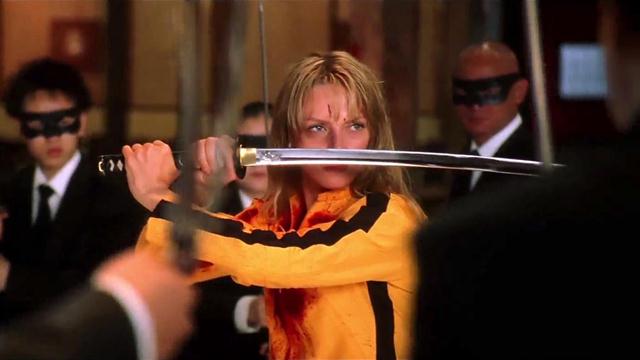 Miramax. “The Crazy 88’s.” Photo. Miramax.com. Accessed November 02, 2015. http://www.miramax.com/movie/kill-bill-volume-1/
Miramax. “The Crazy 88’s.” Photo. Miramax.com. Accessed November 02, 2015. http://www.miramax.com/movie/kill-bill-volume-1/
“Kill Bill – The Bride VS. Gogo and The Crazy 88’s (Alternate Version)” YouTube video, 10:02, a video taken from the Japanese Unrated Limited Edition DVD of Kill Bill, posted by Autonomic, accessed on November 02, 2015. https://www.youtube.com/watch?v=a3aFv8IQb4s.
I am a big Bruce Lee fan. He wore the trademark black striped yellow jumpsuit in his 1978 movie “Game of Death.”21 The Bride was costumed similarly in the katana showdown and thus drew my interest into wanting to do a homage to both films with a medieval manuscript illustration. In fact I was so excited that I jumped on the project without proper background research work done, and went way off model in my first attempt as seen below:
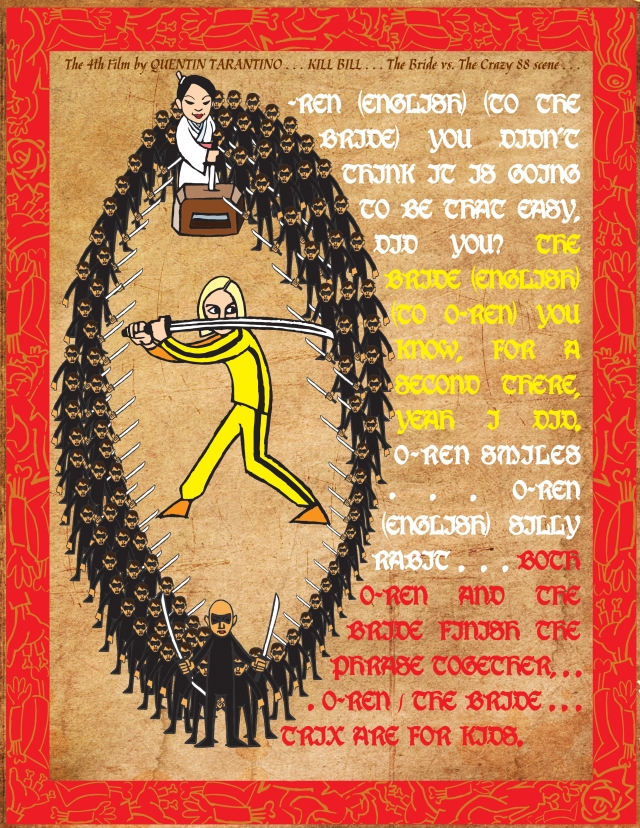 Sen Lieh Kiew, The Bride Vs. The Crazy 88’s Manuscript v1.0, October 14, 2015, Adobe Illustrator Digital Illustration, approx. 8.5″ X11″ @ 300dpi.
Sen Lieh Kiew, The Bride Vs. The Crazy 88’s Manuscript v1.0, October 14, 2015, Adobe Illustrator Digital Illustration, approx. 8.5″ X11″ @ 300dpi.
Most surviving manuscripts between 600 – 1300 AD do not have massive overlapping of human figures. Thus the mass of Crazy 88’s figures forming the black “O” of the name O-ren would be an unlikely design choice a medieval monk would make. The border with uneven outlined decapitated body parts is off-model from most manuscript borders which does not have overtly varied line thickness in their border patterns. Also, authentic manuscript border patterns are not clipped off abruptly at the edges of the borders. The use of fully justified text that wraps around the massive “O” is also off-model . Plus the style employed in drawing humans is too naturalistic compared to Medieval model.
As such, I started the project from scratch with focused research on the Book of Kells as the canon for my version two of medieval illustration. I took inspiration from the following four main pages:
 Book of Kells – Folio 3r, 4r, 7v and 20v, c.AD790, Illuminated manuscripts, ink on vellum (parchment), approximately 13”X10”
Book of Kells – Folio 3r, 4r, 7v and 20v, c.AD790, Illuminated manuscripts, ink on vellum (parchment), approximately 13”X10”
Based on the Book of Kells’ Folio 4r’s general Roman Arch architectural layout, I took a spin and design my manuscript based on Japanese torii gate structure because the Kill Bill katana showdown scene happened in Japan. The following is my version 2 result.
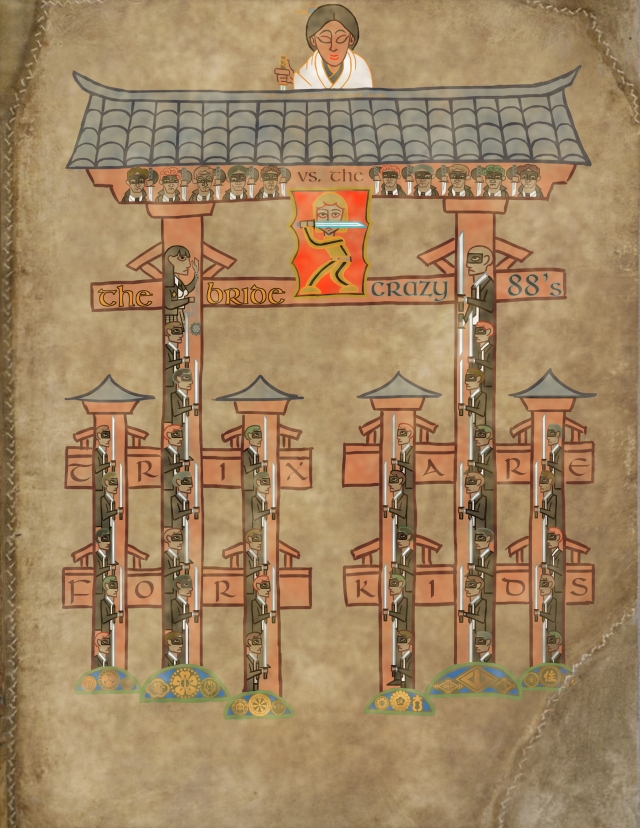 Sen Lieh Kiew, The Bride Vs. The Crazy 88’s Manuscript v2.0, October 31, 2015, Adobe Photoshop Digital Illustration, approx. 8.5″ X11″ @ 300dpi.
Sen Lieh Kiew, The Bride Vs. The Crazy 88’s Manuscript v2.0, October 31, 2015, Adobe Photoshop Digital Illustration, approx. 8.5″ X11″ @ 300dpi.
Here is my manuscript design placed side by side with the Book of Kells’ Folio 4r:
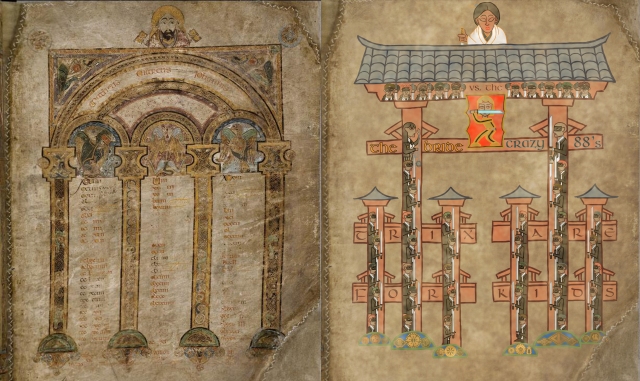 Left: Book of Kells – Folio, 4r, c.AD790, Illuminated manuscripts, ink on vellum (parchment), approximately 13”X10”Right: Sen Lieh Kiew, The Bride Vs. The Crazy 88’s Manuscript v2.0, October 31, 2015, Adobe Photoshop Digital Illustration, approx. 8.5″ X11″ @ 300dpi.
Left: Book of Kells – Folio, 4r, c.AD790, Illuminated manuscripts, ink on vellum (parchment), approximately 13”X10”Right: Sen Lieh Kiew, The Bride Vs. The Crazy 88’s Manuscript v2.0, October 31, 2015, Adobe Photoshop Digital Illustration, approx. 8.5″ X11″ @ 300dpi.
The Roman Arch columns layout page of the Book of Kells was chosen as the primary canon for my Kill Bill manuscript because similar Roman Arch columns typographical layouts were repeated 8 times at the beginning of the book from Folio 1v-5r.
In emulation of the Christ or God the Father figure at the top of Folio 4r, I placed the figure of O-ren Ishii from Kill Bill who was standing at a higher platform in the katana showdown scene. I chose to pose O-ren at the moment when she knifed down her wakizashi (mini-katana) on the balcony railing, summoning the Crazy 88’s. I deliberately posed her hand holding the wakizashi to her right (despite the fact that O-ren knifed the wakizashi towards her front center in the movie) to keep to the generally non-overlapping human forms model of the Book of Kells. In my attempt to keep O-ren as close to model as how the monk in charged of Folio 4r would draw her, I traced her general form from the Christ or God the Father figure, removed the moustache, closed the eyes and angled it more to give a more Asian feel, and changed the hair and clothing color. Closing O-ren’s eyes would probably throw her off-model from the Book of Kells, but I decided to do it because it helps to accentuate her Asian quality and also her misplaced conceit that the greater numbers of The Crazy 88’s would overpower The Bride.
 Left: Book of Kells – Folio, 4r – Christ figure, c.AD790, Illuminated manuscripts, ink on vellum (parchment), approximately 13”X10”
Left: Book of Kells – Folio, 4r – Christ figure, c.AD790, Illuminated manuscripts, ink on vellum (parchment), approximately 13”X10”
Right: Sen Lieh Kiew, The Bride Vs. The Crazy 88’s Manuscript v2.0 – O-ren Ishii figure, October 31, 2015, Adobe Photoshop Digital Illustration, approx. 8.5″ X11″ @ 300dpi.
Straight below the Christ figure of Folip 4r are three delicately colored and illuminated creatures enclosed in three Roman Arches. Instead of following the Folio 4r canon strictly as I have a torii gate layout to wrestle with, I decided to place The Bride in the gakuzuka area (middle) of the torii structure with GoGo Yubari and Johnny Mo flanking her at the top of the longest vertical columns of the torii. As GoGo and Johnny shared area with the other Crazy 88’s, I differentiated them from the less martial arts skilled lackeys through bigger size variation and a break from the general raised katana pose.
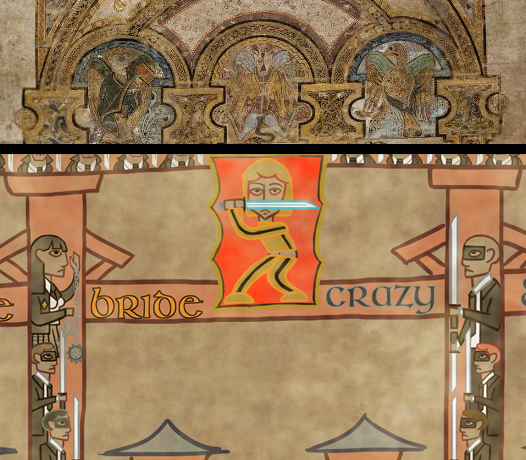 Top: Book of Kells – Folio, 4r – three creatures in Roman Arches, c.AD790, Illuminated manuscripts, ink on vellum (parchment), approximately 13”X10”
Top: Book of Kells – Folio, 4r – three creatures in Roman Arches, c.AD790, Illuminated manuscripts, ink on vellum (parchment), approximately 13”X10”
Bottom: Sen Lieh Kiew, The Bride Vs. The Crazy 88’s Manuscript v2.0 – GoGo Yubari, The Bride, and Johnny Mo, October 31, 2015, Adobe Photoshop Digital Illustration, approx. 8.5″ X11″ @ 300dpi.
It is my intention that all yellow outlines be representation of gold gilded linings and the blue grey outlines be representation of silver gilded linings of Folio 4r. This would make The Bride opulently lined in gold with her katana lined in silver while O-ren’s kimono opulently lined in gold with a hint of silver lined blade of her wakizashi and hair pin. Both of these characters are the only ones who have both gold and silver linings to distinguish their status from the other side characters.
For the general solid outline and enclosed area coloring, I picked colors from Folio 3r, 4r, 7v and 20v of the Book of Kells. However, I went off-model for the red surrounding The Bride as I needed a stronger red to pop the yellow of The Bride to emphasize the moment illustrated as part of her road to vengeance and foreshadow the bloody outcome of the katana showdown.
Instead of having abstract knot-like patterns that fill the architectural columns in Folio 4r, I populated my torii columns with Crazy 88’s figures with some overlapping. Conservative overlapping of figures does happen in Folio 202v of the Book of Kells.
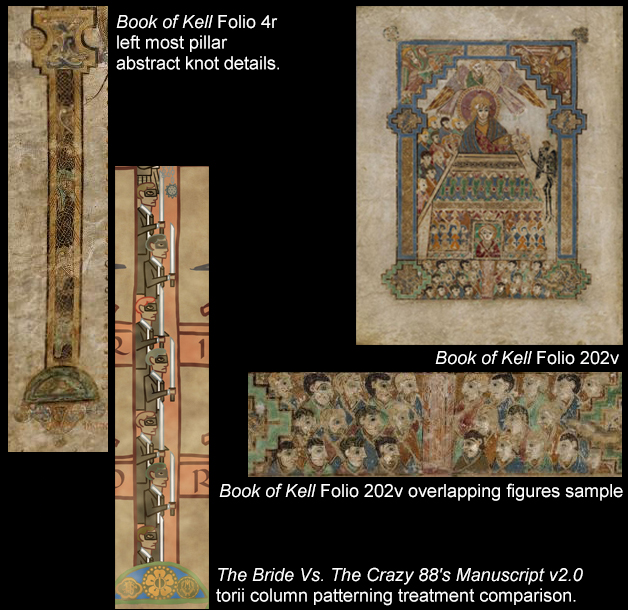 Left: Book of Kells – Folio, 4r – left most column patterning details, c.AD790, Illuminated manuscripts, ink on vellum (parchment), approximately 13”X10”
Left: Book of Kells – Folio, 4r – left most column patterning details, c.AD790, Illuminated manuscripts, ink on vellum (parchment), approximately 13”X10”
Middle: Sen Lieh Kiew, The Bride Vs. The Crazy 88’s Manuscript v2.0 – torii vertical column patterning detail sample, October 31, 2015, Adobe Photoshop Digital Illustration, approx. 8.5″ X11″ @ 300dpi.
Right Top: Book of Kells – Folio, 202v, c.AD790, Illuminated manuscripts, ink on vellum (parchment), approximately 13”X10”
Right Bottom: Book of Kells – Folio, 202v – bottom border overlapping figures sample , c.AD790, Illuminated manuscripts, ink on vellum (parchment), approximately 13”X10”
For the top most horizontal sture of my torii, I filled it with front facing Crazy 88’s, with miniaturized katanas (due to space constraints) pointing towards The Bride, in emulation of the style (including the hair-styles) of front facing figures of Folio 202v.
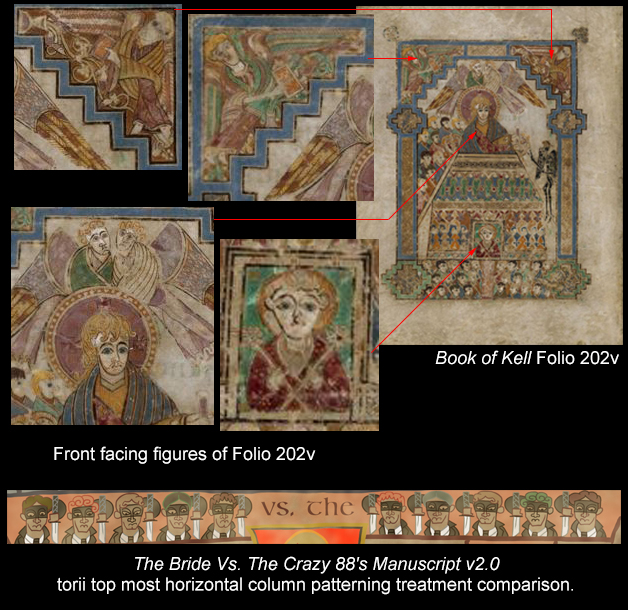 Top: Book of Kells – Folio, 202v – front facing character details, c.AD790, Illuminated manuscripts, ink on vellum (parchment), approximately 13”X10”
Top: Book of Kells – Folio, 202v – front facing character details, c.AD790, Illuminated manuscripts, ink on vellum (parchment), approximately 13”X10”
Bottom: Sen Lieh Kiew, The Bride Vs. The Crazy 88’s Manuscript v2.0 – torii top most horizontal column patterning detail sample, October 31, 2015, Adobe Photoshop Digital Illustration, approx. 8.5″ X11″ @ 300dpi.
While studying Folio 202v, I realized that human figures were illustrated with serpentine curve elbows in the Book of Kells. In this regard, my side facing Crazy 88’s are off-model as they have more angular looking elbows. But because it would be time-consuming to re-work all the angular elbows in view of the impending deadline, I decided to keep them as is. Instead, I emphasized the serpentine nature of the front facing Crazy 88’s and also ensured The Bride’s limbs are serpentine looking to establish my knowledge of this aspect the Book of Kell canon.
A manuscript without text would not be complete. Before the katana showdown, both O-ren and The Bride whispered “Trix are for kids” together. I used that as the basis for the main text in my manuscript design, spacing the alphabets out in the shorter horizontal beams of the torii. I used the upper case for this main text in emulation of Greek and Roman approach of writing in all caps in antiquity which the Book of Kells adopted for some of its Folios. Given more time, I would have designed my own squarish calligraphic all caps font (more in line with the Book of Kells with an Oriental feel) to fill the squarish torii horizontal beam spaces to the edges. But due to time constraint, I have to use generic Carolingian font as a place holder to communicate my unfulfilled design desire.
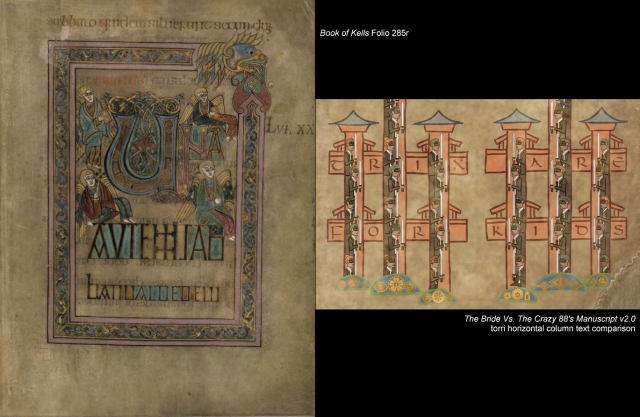 Top: Book of Kells – Folio, 285r – all caps text arrangement sample, c.AD790, Illuminated manuscripts, ink on vellum (parchment), approximately 13”X10”
Top: Book of Kells – Folio, 285r – all caps text arrangement sample, c.AD790, Illuminated manuscripts, ink on vellum (parchment), approximately 13”X10”
Bottom: Sen Lieh Kiew, The Bride Vs. The Crazy 88’s Manuscript v2.0 – torii horizontal column all caps text samples, October 31, 2015, Adobe Photoshop Digital Illustration, approx. 8.5″ X11″ @ 300dpi.
While we are at the bottom portion of the torii, I would like to highlight two deliberate design choices I made that may be off-model from the Book of Kells. Firstly, a typical larger scale torii has four shorter vertical columns flanking the front and back of the two longer vertical columns as seen below:
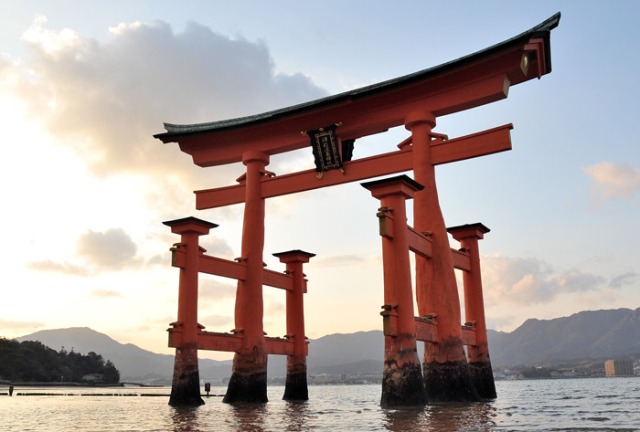 The great Torii of Miyajima. Miyajima Official Tourism Website . Accessed November 3, 2015. http://visit-miyajima-japan.com/en/culture-and-heritage/spiritual-heritage-temples-shrines/le-torii-flottant.html
The great Torii of Miyajima. Miyajima Official Tourism Website . Accessed November 3, 2015. http://visit-miyajima-japan.com/en/culture-and-heritage/spiritual-heritage-temples-shrines/le-torii-flottant.html
I placed the four shorter vertical torii columns on the left and right of the two longer torii columns respectively to avoid linear perspective from occurring to keep to the Book of Kells canon. But I staggered the semi hemispheric base of my torii design to break monotony (unlike the Roman arch column bases of Folio 4r) while giving a hint of a primitive attempt in achieving perspective without size variation, overlapping form, or linear perspective.
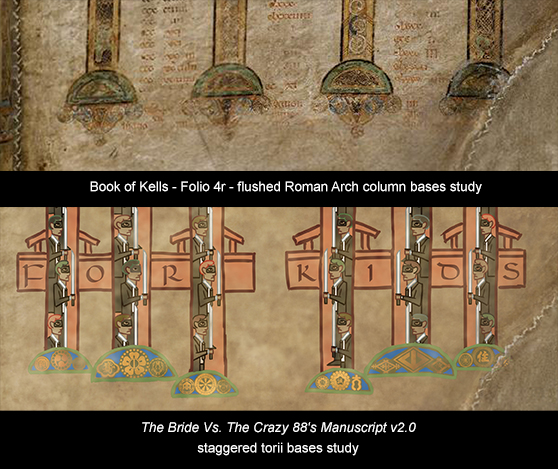 Top: Book of Kells – Folio, 4r – flushed Roman Arch column bases study, c.AD790, Illuminated manuscripts, ink on vellum (parchment), approximately 13”X10”
Top: Book of Kells – Folio, 4r – flushed Roman Arch column bases study, c.AD790, Illuminated manuscripts, ink on vellum (parchment), approximately 13”X10”
Bottom: Sen Lieh Kiew, The Bride Vs. The Crazy 88’s Manuscript v2.0 – staggered torii bases study, October 31, 2015, Adobe Photoshop Digital Illustration, approx. 8.5″ X11″ @ 300dpi.
Secondly, for the semi-hemispheric base patterning, the Book of Kells has abstract knotted pattens as decorative fillers. I chose to find existing Yakuza mons (clan crest) from https://en.wikipedia.org/wiki/Yakuza (I would have used a more reliable source than wikipedia if I have more time and resources to Japanese literature) as decorative fillers instead. This is an attempt to make more culturally meaningful decoration and keep in tune with the Kill Bill storyline where O-ren was the ultimate head of the Yakuza clans.
The title of the manuscript “The Bride vs. The Crazy 88’s” was placed along the top two horizontal beams of the torii with a mixture of upper and lower casing in tune with the writing style of the Book of Kells. I would have written them from scratch to be more in model with the Book of Kells if given more time. The same goes for the credit given to Quentin Tarantino at the top most horizontal roof beam in gold, right below O-ren. I black outline the yellow “The Bride” word to match her Bruce Lee jump suit. According to Folio 4r, outlining of text is possible to be on model with the Book of Kells.
Though my work was not perfectly on model with the Book of Kells as listed in my formal analysis above, I know where I am off-model deliberately or due to lack of time. If given more time, I am sure I will do an even better job on the third try.

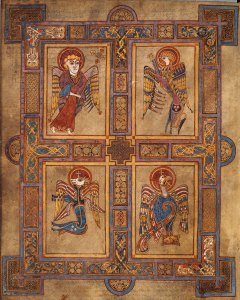
An excellent article on using a medieval style to illustrate a modern artwork. I am passing this on to others I know who enjoy the “traditional” style of medieval illumination.
LikeLiked by 1 person